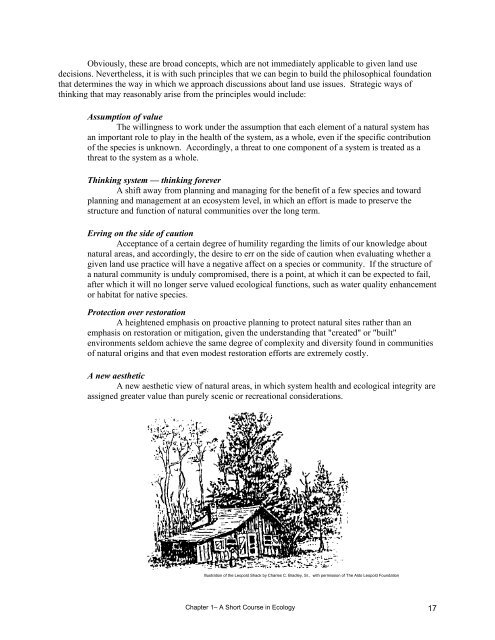Guide to Significant Wildlife Habitat - Door County Web Map
Guide to Significant Wildlife Habitat - Door County Web Map
Guide to Significant Wildlife Habitat - Door County Web Map
Create successful ePaper yourself
Turn your PDF publications into a flip-book with our unique Google optimized e-Paper software.
Obviously, these are broad concepts, which are not immediately applicable <strong>to</strong> given land use<br />
decisions. Nevertheless, it is with such principles that we can begin <strong>to</strong> build the philosophical foundation<br />
that determines the way in which we approach discussions about land use issues. Strategic ways of<br />
thinking that may reasonably arise from the principles would include:<br />
Assumption of value<br />
The willingness <strong>to</strong> work under the assumption that each element of a natural system has<br />
an important role <strong>to</strong> play in the health of the system, as a whole, even if the specific contribution<br />
of the species is unknown. Accordingly, a threat <strong>to</strong> one component of a system is treated as a<br />
threat <strong>to</strong> the system as a whole.<br />
Thinking system — thinking forever<br />
A shift away from planning and managing for the benefit of a few species and <strong>to</strong>ward<br />
planning and management at an ecosystem level, in which an effort is made <strong>to</strong> preserve the<br />
structure and function of natural communities over the long term.<br />
Erring on the side of caution<br />
Acceptance of a certain degree of humility regarding the limits of our knowledge about<br />
natural areas, and accordingly, the desire <strong>to</strong> err on the side of caution when evaluating whether a<br />
given land use practice will have a negative affect on a species or community. If the structure of<br />
a natural community is unduly compromised, there is a point, at which it can be expected <strong>to</strong> fail,<br />
after which it will no longer serve valued ecological functions, such as water quality enhancement<br />
or habitat for native species.<br />
Protection over res<strong>to</strong>ration<br />
A heightened emphasis on proactive planning <strong>to</strong> protect natural sites rather than an<br />
emphasis on res<strong>to</strong>ration or mitigation, given the understanding that "created" or "built"<br />
environments seldom achieve the same degree of complexity and diversity found in communities<br />
of natural origins and that even modest res<strong>to</strong>ration efforts are extremely costly.<br />
A new aesthetic<br />
A new aesthetic view of natural areas, in which system health and ecological integrity are<br />
assigned greater value than purely scenic or recreational considerations.<br />
Illustration of the Leopold Shack by Charles C. Bradley, Sr., with permission of The Aldo Leopold Foundation<br />
Chapter 1– A Short Course in Ecology 17





![A Guide to the Control and Management of Invasive Phragmites [PDF]](https://img.yumpu.com/19126786/1/190x190/a-guide-to-the-control-and-management-of-invasive-phragmites-pdf.jpg?quality=85)






![Homeowner's Guide to Japanese Knotweed Control [PDF]](https://img.yumpu.com/19126766/1/190x245/homeowners-guide-to-japanese-knotweed-control-pdf.jpg?quality=85)




